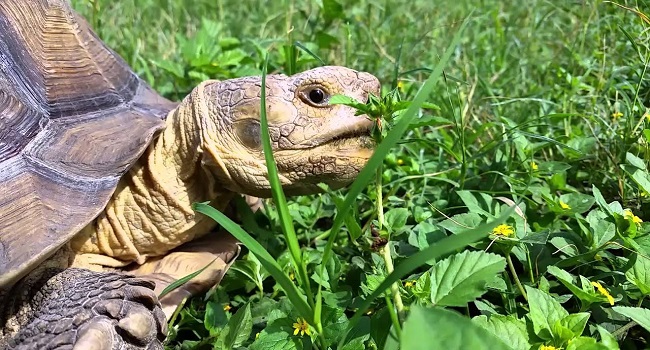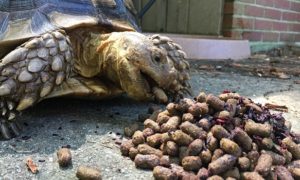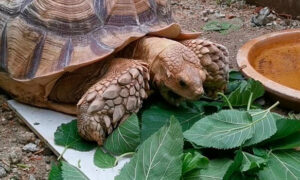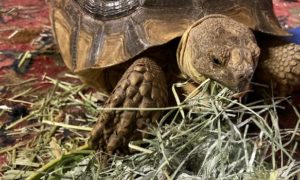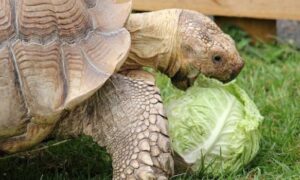Grass should be the main component of your sulcata tortoise’s diet, however sulcatas are opportunistic feeders. They will try just about anything once to see if it’s edible, which is why it is important to check your yard for poisonous plants.
Many plants, or parts of the plants, have some toxicity to tortoises. Some plants should be avoided completely, whereas others should be limited. Do not assume your tortoise will know the difference between non-poisonous and poisonous plants. In most cases, if it’s green or colorful, your tortoise will try it. If you can identify a plant or weed, you there are online sources where you can upload a picture, but for the best means to identify a plant is to take it to a local nursery.
Toxicity Levels
1. Oxalates – Plants with oxalates should be limited. Oxalates is an anti-nutrient that can steal nutrients from the body. In excess, oxalates can cause problems with the kidneys or gallbladder, as well as interfere with iron and calcium absorption.
2. Toxic or Potentially Toxic – Toxic plants may contain a wide variety of substances that can cause ill effects for a tortoise. The toxicity can range from mild irritation to severe organ damage.
3. Dermatitis – These plants can produce a rash, itch or other skin irritation.
4. Unknown/Incomplete – There just isn’t enough data to confirm the toxicity of these plants or parts of the plants.
| Common Name | Botanical Name | Toxicity |
|---|---|---|
| Amaryllis | Amaryllis belladonna | 2 |
| Asparagus Fern | Asparagus sprengerii | 2, 3 |
| Arrowhead Vine | Syngonium podophyllum | 1 |
| Avocado (leaves, seeds) | Persea americana | 2 |
| Azalea | Rhododendron species | 2 |
| Begonia | Begonia | 1 |
| Bird of Paradise | Poinciana gilliesii | 2 |
| Boston Ivy | Parthenocissus tricuspidata | 1 |
| Boxwood | Buxus sempervirens | 2, 3 |
| Buttercup family | Ranunculus species | 2, 3 |
| Calla Lily | Zantedeschia species | 1 |
| Candytuft | Iberis species | 3 |
| Carolina Jessamine | Gelsemium sempervirens | 2 |
| Castor Bean | Ricinus communis | 2 |
| Chinese Evergreen | Aglaonema modestum | 1 |
| Chinaberry | Melia azedarach | 2 |
| Columbine | Aquilegia species | 2 |
| Creeping Charlie | Glechoma hederacea | 2 |
| Crowfoot | Ranunculus sceleratus | 2, 3 |
| Cyclamen | Cyclamen persicum | 2 |
| Daffodil | Narcissus species | 2 |
| Delphinium, Larkspur | Delphinium species | 2 |
| Dianthus, Carnation | Dianthus species | 2 |
| Dumb cane | Dieffenbachia amoena | 1 |
| Elephant’s Ear | Philodendron hastatum | 1, 3 |
| Euphobia (all) | Euphorbia species | 2, 4 |
| Ficus (all) | Ficus species | 3 |
| Firethorn | Pyracantha coccinea | 1, 3 |
| Foxglove | Digitalis purpurea | 2 |
| Gardenia | Gardenia | 4 |
| Grape Ivy | Cissus rhombifolia | 4 |
| Heavenly Bamboo | Nandina domestica | 2 |
| Holly | Ilex species | 2 |
| Hyacinth | Hyacinthus orientalis | 2 |
| Hydrangea | Hydrangea species | 2 |
| Ivy | Hedera helix | 2, 3 |
| Iris (esp. rhizome) | Iris species | 2, 3 |
| Jerusalem Cherry | Solanum pseudocapsicum | 2 |
| Juniper | Juniperus species | 2 |
| Lantana | Lantana camara | 2, 3 |
| Lily of the Nile | Agapanthus africanus | 2, 3 |
| Lily of the Valley | Convallaria species | 2, 3 |
| Lobelia | Lobelia | 2 |
| Lupine | Lupinus species | 2, 3 |
| Marsh Marigold, Cowslip | Caltha palustris | ? |
| Nightshade family | Solanum species | 2 |
| Oleander | Nerium oleander | 2 |
| Periwinkle | Vinca species | 2 |
| Philodendron | Philodendron species | 2 |
| Poinsettia | Euphorbia pulcherrima | 4 |
| Pothos | Epipremnum aureum | 1, 3 |
| Primrose | Primula species | 3 |
| Rosary Bean | Abrus precatarius | 2 |
| Shasta Daisy | Chrysanthemum maximum | 2, 3 |
| Spider Mum | Chrysanthemum morifolium | 2, 3, 4 |
| Splitleaf Philodendron | Monstera deliciosa | 1 |
| String of Pearls | Senecio rowleyanus, S. herrieanus | 2 |
| Sweet Pea (seeds) | Lathyrus odoratus | 4 |
| Tomato (leaves, vines) | Solanum lycopersicum | 2 |
| Umbrella Tree | Schefflera actinophylla | 1, 3 |

